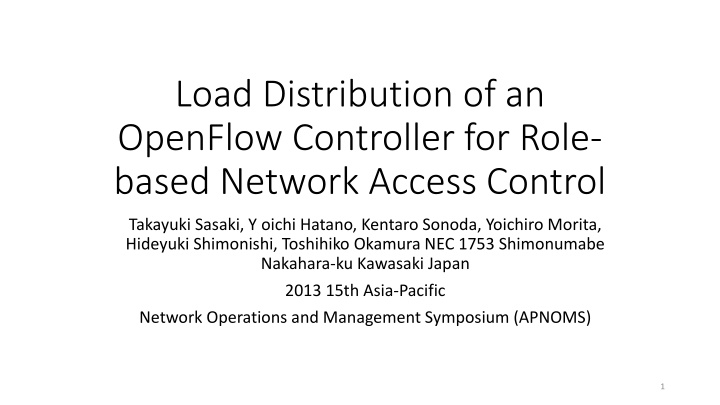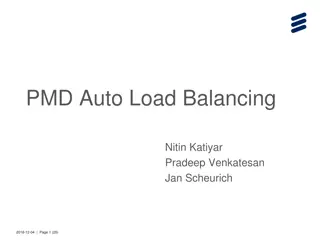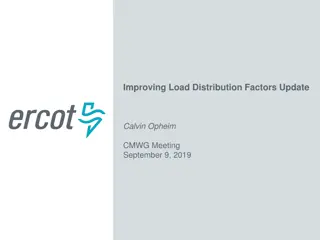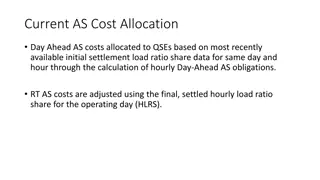
Role-Based Network Access Control with Load Distribution in OpenFlow
Explore the implementation of Role-Based Access Control (RBAC) in OpenFlow networks to enhance security against internal threats. Learn about load distribution strategies for the OpenFlow controller, improving system performance and scalability.
Download Presentation

Please find below an Image/Link to download the presentation.
The content on the website is provided AS IS for your information and personal use only. It may not be sold, licensed, or shared on other websites without obtaining consent from the author. If you encounter any issues during the download, it is possible that the publisher has removed the file from their server.
You are allowed to download the files provided on this website for personal or commercial use, subject to the condition that they are used lawfully. All files are the property of their respective owners.
The content on the website is provided AS IS for your information and personal use only. It may not be sold, licensed, or shared on other websites without obtaining consent from the author.
E N D
Presentation Transcript
Load Distribution of an OpenFlow Controller for Role- based Network Access Control Takayuki Sasaki, Y oichi Hatano, Kentaro Sonoda, Yoichiro Morita, Hideyuki Shimonishi, Toshihiko Okamura NEC 1753 Shimonumabe Nakahara-ku Kawasaki Japan 2013 15th Asia-Pacific Network Operations and Management Symposium (APNOMS) 1
Outline Introduction Background knowledge OpenFlow Role Based Access Control(RBAC) Ideas Approaches of Performance Improvement System Architecture RBAC rule conversion Performance evaluation Conclusion 3
Introduction Network attacks have been coming from outside networks such as internet, and the attacks are prevented by a firewall at the border between inside and outside of a network. But in recent years, the attacks also have been coming from internal network due to malware infected clients and malicious insiders. 4
Background knowledge OpenFlow Role Based Access Control(RBAC) 5
OpenFlow In the OpenFlow architecture, the OpenFlow controller is a single point to make decisions, thus in large network the controller must process all inquiries from OpenFlow switches. Therefore, in large network, the OpenFlow controller may become a bottleneck of the system. 6
Role Based Access Control(RBAC) RBAC defines roles as collections of rights, and roles are assigned to users, then it performs access control on the basis of the assigned roles. To reduce difficulty of policy writing, role definition and role assignment can be specified by different administrators However, the proposed system has a scalability problem due to centralized architecture, because the OpenFlow controller is a single point to be responsible for control of whole network. Specifically, it monitors all traffics by receiving queries from OpenFlow switches, and it performs policy decision and returns a result of the decision to the OpenFlow switches. 7
Ideas Policy decision at switch side: This idea distributes the load of the controller to switches. OpenFlow architecture performs all access control decisions at the controller, on the other hand the proposed architecture performs the decisions at switch side according to pre- distributed rules. Pre-distribution of the rules: For temporal load balancing, the controller dynamically distributes only role assignments to the switches, and role definitions are distributed in advance. 8
Approaches of Performance Improvement Well-known approaches used for distributed systems Horizontal load distribution This approach improves the controller performance using parallelization techniques. Solution Multiple controller architecture Vertical load distribution Based on this approach, the policy decision functionality can be performed by OpenFlow switches for reducing the controller load. Solution Functional load distribution to the switch Temporal load distribution This approach distributes a peak load by preprocessing. Proactive mode is a kind of this approach, and it distributes rules in advance for reducing queries from OpenFlow switches , but access control rules can not be distributed in advance. Solution Temporal load distribution of rule distribution 9
Performance evaluation estimate the size of ACL rules and RBAC rules 1. A user has only one role and each server is specified by one role. 2. The rules are specified using IP addresses. 3. Ignore port numbers of TCP and UDP. 4. 300 researchers/ 30 roles a) Size of ACL rules = C * P ; 7695=517 * P ; P 14.9 b) Size of RBAC rules = C + R * P ; 517(PA) + 30 * 14.9(UA) = 964 Rule reduction ratio = (7695 -964)/7695=87% C number of clients ;517 P average number of servers allowed by a role R number of roles ; 30 12
Conclusion According to experiment result, they estimated the number of rules and identified that RBAC reduces rule size by 87% , thus these switches can store all rules in this case. Furthermore, the half of RBAC rules (permission assignments) can be distributed in advance, thus their architecture reduces the size of dynamically distributed rules by 93% ((7696-517)/7695)compared with ACL rules. 14






















